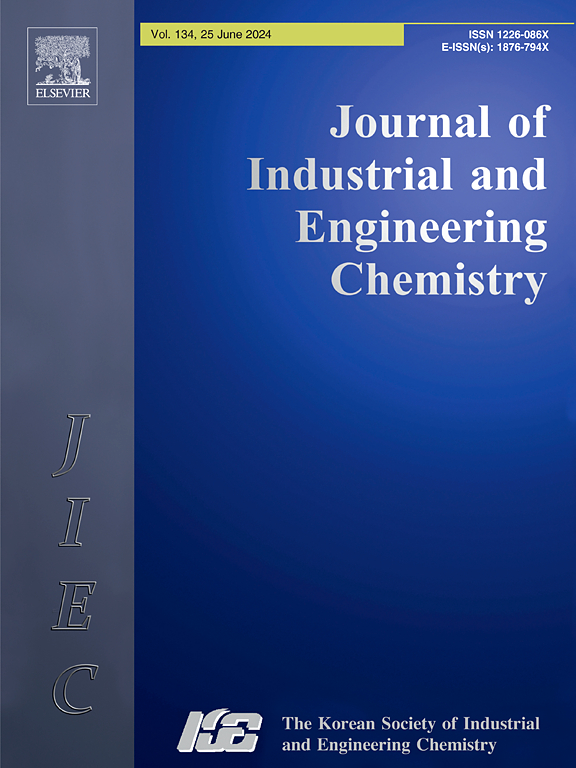氧空位介导TiO2-x-MoS2/FTO异质结构作为光电化学水分解的高效光阳极
IF 5.9
3区 工程技术
Q1 CHEMISTRY, MULTIDISCIPLINARY
Journal of Industrial and Engineering Chemistry
Pub Date : 2024-11-28
DOI:10.1016/j.jiec.2024.11.043
引用次数: 0
摘要
为了实现完整的水分解循环,太阳能辅助氧化起着至关重要的作用。发现能够吸收可见光的高效光电阳极对于实现具有成本效益的太阳能转换至关重要。本研究设计了一种高效的水热方法,在FTO(氟掺杂氧化锡)上合成了具有氧空位的TiO2-MoS2异质结构。利用各种技术研究了TiO2-x-MoS2异质结构的结构、形貌、光学性质和光电催化行为。氧空位态可以在TiO2的导带下方形成新的亚能级态,使带隙缩小到更低的能级,从而将吸收边缘延伸到可见光区。氧空位策略使TiO2光电流密度达到0.6 mA cm-2,是纯TiO2的3倍。此外,TiO2-x- mos2异质结构的光电流密度为2.6 mA cm−2,在1.0 M KOH溶液中,在UV-Vis照射下,TiO2-x- mos2异质结构的O2析出率高于纯TiO2。与未经修饰的TiO2纳米棒相比,TiO2-x- mos2电极的光电化学活性提高了13倍,并且具有较低的过电位。这是由于TiO2-x-MoS2界面的电子传递动力学加速,载流子密度增强,电荷重组速率降低,表面高度可湿性。本文章由计算机程序翻译,如有差异,请以英文原文为准。

Oxygen vacancy mediated TiO2-x-MoS2/FTO heterostructure as an efficient photoanode for photoelectrochemical water splitting
To achieve a complete water splitting cycle, solar-assisted oxidation plays a crucial role. Discovering efficient photoanodes capable of absorbing visible light is essential to enable cost-effective solar energy conversion. This study devised an efficient hydrothermal method to synthesize a TiO2-MoS2 heterostructure with an oxygen vacancy on FTO (fluorine-doped tin oxide). The structure, morphology, optical properties, and photoelectrocatalytic behavior of the TiO2-x-MoS2 heterostructure using various techniques. The oxygen vacancy state can create a new sublevel state below the conduction band of TiO2, which narrows the band gap to a lower level and thus extends the absorption edge into the visible region. The strategy of oxygen vacancy resulted in a photocurrent density of 0.6 mA cm-2, which is 3 times higher than pure TiO2. Also, the TiO2-x-MoS2 heterostructure exhibits a photocurrent density of 2.6 mA cm−2 and higher O2 evolution than pure TiO2 in a 1.0 M KOH solution under UV–Vis irradiation. Compared to unmodified TiO2 nanorods, TiO2-x-MoS2 electrodes exhibit an increase of 13 times in photoelectrochemical activity and have a low overpotential. This is due to accelerated electron transfer kinetics at the TiO2-x-MoS2 interface, an enhanced density of charge carriers, a reduced rate of charge recombination, and a highly wettable surface.
求助全文
通过发布文献求助,成功后即可免费获取论文全文。
去求助
来源期刊
CiteScore
10.40
自引率
6.60%
发文量
639
审稿时长
29 days
期刊介绍:
Journal of Industrial and Engineering Chemistry is published monthly in English by the Korean Society of Industrial and Engineering Chemistry. JIEC brings together multidisciplinary interests in one journal and is to disseminate information on all aspects of research and development in industrial and engineering chemistry. Contributions in the form of research articles, short communications, notes and reviews are considered for publication. The editors welcome original contributions that have not been and are not to be published elsewhere. Instruction to authors and a manuscript submissions form are printed at the end of each issue. Bulk reprints of individual articles can be ordered. This publication is partially supported by Korea Research Foundation and the Korean Federation of Science and Technology Societies.

 求助内容:
求助内容: 应助结果提醒方式:
应助结果提醒方式:


